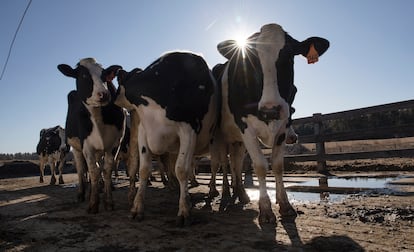Study confirms deadly bird flu is being transmitted between cows
American researchers warn that ‘efficient and sustained mammal-to-mammal transmission is unprecedented’ and is occurring among asymptomatic cattle

A scientific team has confirmed the most feared scenario: the highly pathogenic avian influenza virus, which has been spreading through U.S. dairy farms for months, has managed to jump from cow to cow, and from cattle to cats and a raccoon. The researchers, from Cornell University, have issued a warning. “Efficient and sustained mammal-to-mammal transmission is unprecedented. It is worrisome because it may cause the virus to adapt, enhancing its infectivity and transmissibility to other species, including people,” the researchers note in their study, which was published urgently Wednesday in the journal Nature. The authors call for strict measures to prevent transmission to cows and to “reduce the risk of a pandemic in humans.”
The world is currently experiencing the biggest avian influenza crisis ever known. A subtype of the H5N1 virus, designated 2.3.4.4b, emerged in 2021 in wild birds and has since killed hundreds of millions of birds worldwide. The World Health Organization still considers the risk to the public to be “low,” although its records show that the H5N1 virus has jumped from birds to at least 889 people since 2003, killing 463 of them (52%). Scientists’ worst nightmare is that a virus with such lethality will mutate and become capable of human-to-human transmission, which has not happened so far.
Cornell researchers, led by Brazilian virologist Diego Diel, have observed that this subtype of the virus has a strong ability to infect udder cells and concentrate in milk, although it also appears in the lungs of cows. Scientists speculate that the pathogen may be transmitted via the respiratory or oral route, but they also suspect that it could enter through the teat orifice from contaminated soil or milking machines. As for the cats and the raccoon, the hypothesis is that they became infected by drinking contaminated milk. Two months ago, an experiment on mice showed that raw milk may contain viruses capable of transmitting the disease.
Virologist Elisa Pérez is concerned about what is happening in the U.S., where 168 affected herds in 13 states have been identified since the first case was detected in a cow on March 25. “It is very worrying, because it implies that cows constitute a new reservoir of avian influenza — at least of this particular genotype — and that they can act as a source of infection for other species, both birds and mammals. This is something that had never been observed before with this virus, since the only natural reservoir of avian influenza was birds,” says the expert, from the Animal Health Research Center in Madrid. Infected cows may display symptoms such as reduced appetite, digestive disorders, respiratory problems and lower milk production. So far, there have only been outbreaks among cattle in the United States.
The nine farms tested in the study are in Texas, New Mexico, Ohio, and Kansas. They are outdoor farms, where wild birds have contact with dairy cows, both directly and indirectly, through contaminated feed or water. The first affected farms are on a route commonly used by migratory birds to cross North America.
On January 25, a scientific team found the B3.13 version of the 2.3.4.4b subtype of the H5N1 virus, the root of the unprecedented outbreaks in dairy cattle, in a Canadian goose in Wyoming. The analysis of the complete genome of the virus in cows has not detected mutations that favor the jump to humans.
Pérez stresses that cows on a farm in Ohio became infected after the arrival of asymptomatic cattle from another facility in Texas. “This confirms that apparently healthy cows can transmit the virus. That is, not all cows develop clinical symptomatology after infection. This has very important implications for surveillance systems,” explains the virologist. “With these data, it is clear that we should not only carry out passive surveillance (testing only samples from cows with symptoms), but it is also essential to include active surveillance programs, such as, for example, testing tank milk on all cattle farms, as will be the case in Colorado, one of the states most severely affected by avian influenza in cows.”
American epidemiologist Maria van Kerkhove, director of the emerging diseases unit of the World Health Organization, declared two months ago that Covid-19 would not be “the last pandemic we will deal with in our lifetimes.” Diel points to H5N1 from his laboratory at Cornell University. “It is difficult to predict which virus will be next but given the propensity of influenza viruses to cause pandemics, it is very important to keep a close eye on the H5N1 situation in dairy cattle,” he explains to EL PAÍS.
The first outbreak that set off alarm bells worldwide occurred at a mink farm in Spain. In autumn 2022, dead seagulls and gannets appeared on Galician beaches. In early October, American mink began to die of hemorrhagic pneumonia at a fur farm in Carral, outside A Coruña. Mortality in the outbreak exceeded 4% in just seven days. A study led by biologist Montserrat Agüero, of the Ministry of Agriculture’s Central Veterinary Laboratory, suggested in January 2023 that the avian flu virus had jumped from wild birds to mink, mutated on the farm, and been transmitted from mammal to mammal. Early last year, the mass death of sea lions from bird flu in Peru suggested that the virus might be jumping between mammals in the wild. Dutch veterinarian Thijs Kuiken, of the Erasmus University Medical Center in Rotterdam, then posed a question in EL PAÍS: “If it occurs in minks and sea lions, why won’t it occur in humans?”
Sign up for our weekly newsletter to get more English-language news coverage from EL PAÍS USA Edition
Tu suscripción se está usando en otro dispositivo
¿Quieres añadir otro usuario a tu suscripción?
Si continúas leyendo en este dispositivo, no se podrá leer en el otro.
FlechaTu suscripción se está usando en otro dispositivo y solo puedes acceder a EL PAÍS desde un dispositivo a la vez.
Si quieres compartir tu cuenta, cambia tu suscripción a la modalidad Premium, así podrás añadir otro usuario. Cada uno accederá con su propia cuenta de email, lo que os permitirá personalizar vuestra experiencia en EL PAÍS.
¿Tienes una suscripción de empresa? Accede aquí para contratar más cuentas.
En el caso de no saber quién está usando tu cuenta, te recomendamos cambiar tu contraseña aquí.
Si decides continuar compartiendo tu cuenta, este mensaje se mostrará en tu dispositivo y en el de la otra persona que está usando tu cuenta de forma indefinida, afectando a tu experiencia de lectura. Puedes consultar aquí los términos y condiciones de la suscripción digital.











































